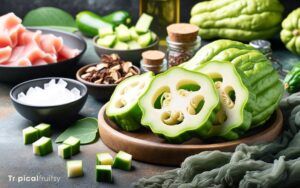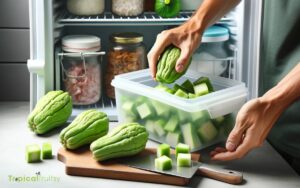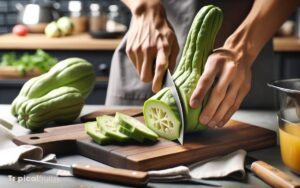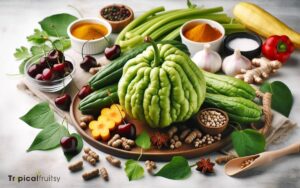How Long Does Chayote Last? Unlocking the Mystery!
Chayote, when stored properly, can last for about 2 to 4 weeks in the refrigerator. To extend its shelf life, keep it in a plastic bag in the crisper drawer to maintain humidity.
Ensure that the chayote is dry and free from cuts or bruises before storing. If you plan to keep it at room temperature, use it within a week for optimal freshness.
Chayote, also known as vegetable pear, is a green, squash-like fruit that is highly perishable.
Its longevity depends on how it is stored:
The signs of a chayote going bad include soft spots, mold growth, and an off smell. To ensure maximum freshness, keep it away from ethylene-producing fruits like bananas and apples, which could speed up the ripening process.
To enjoy chayote’s mild, crisp flavor for as long as possible, proper storage is key; refrigeration can significantly extend its usable life.
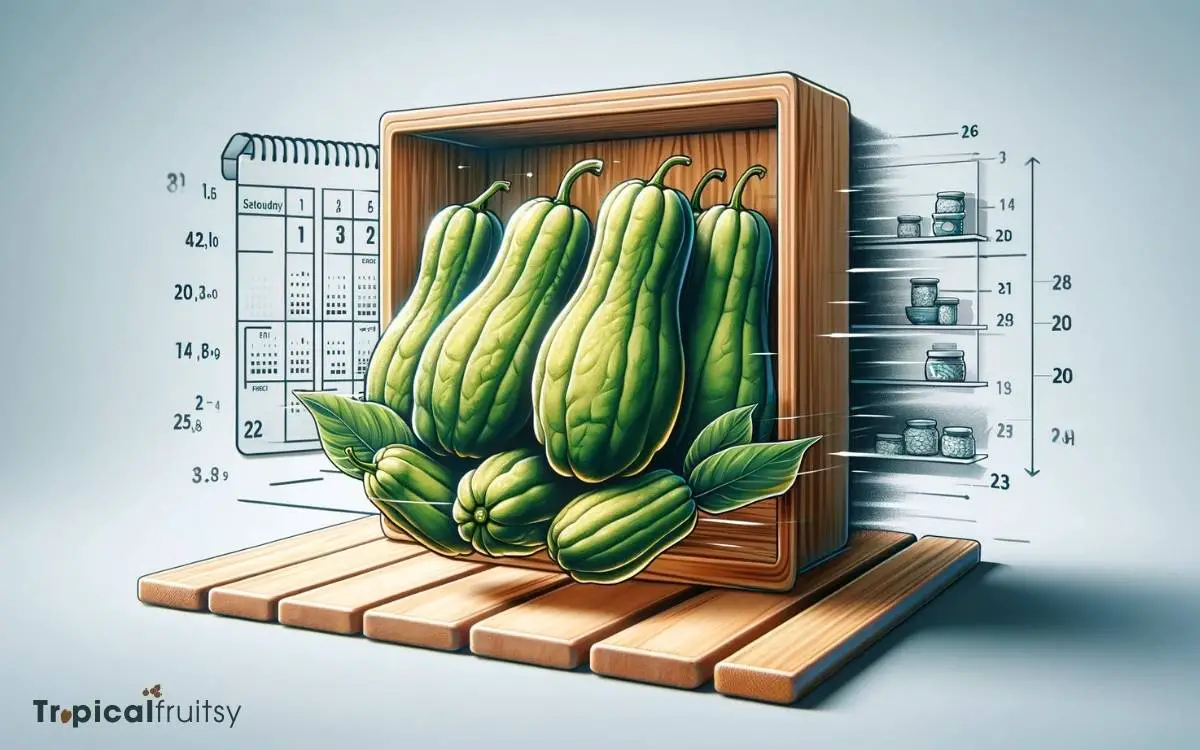
Key Takeaway
Understanding Chayote Freshness
We can gauge the freshness of a chayote by examining its firmness, color, and the absence of blemishes or soft spots.
A fresh chayote should exhibit a bright green hue and possess a uniform, hard-to-the-touch surface. Deviations in color, ranging from yellowing to dark spots, often indicate the onset of decay.
Similarly, the presence of soft regions suggests a breakdown in cellular structure, which compromises the vegetable’s integrity.
It’s essential to apply a consistent pressure when assessing firmness to ensure an accurate reading of the chayote’s condition.
We must also scrutinize the skin for imperfections that could harbor microbial growth, as these factors are critical in determining the chayote’s shelf life and suitability for consumption.
Signs of Chayote Spoilage
We can identify chayote spoilage through observable changes in its color and texture.
Discoloration, such as browning or the presence of dark spots, often indicates spoilage, while a firm texture gives way to softness or sponginess as the vegetable deteriorates.
These alterations are reliable indicators that the chayote is no longer fresh and shouldn’t be consumed.
Color Changes
Chayote’s vibrant green hue fades to a dull yellow or brownish color when it begins to spoil. This discoloration indicates chlorophyll breakdown, a natural pigment responsible for the green coloration in plants.
We analyze this change as a clear sign of degradation, which is often accompanied by a loss of firmness and the development of soft spots.
As the chayote deteriorates further, these discolored areas can become sites for microbial growth, including bacteria and fungi, which may not be immediately visible to the naked eye.
To ensure safety and quality, we recommend discarding chayote showing such color changes. It’s crucial to understand that these alterations aren’t simply cosmetic but are indicative of a compromised structure and potential health hazards.
Texture Differences
Following the visual cues, we’ll notice that a chayote’s texture also changes significantly as it spoils, transitioning from firm and crisp to soft and mushy. This tactile deterioration is a telltale sign of spoilage that we can’t overlook.
To maintain the utmost precision, let’s pinpoint the key textural indicators that signal a chayote is past its prime:
- Loss of Rigidity: A fresh chayote exhibits resistance to pressure, whereas a spoiled one becomes pliable and yields easily under slight force.
- Surface Wrinkling: Initially smooth, the skin of a chayote that’s spoiling will develop wrinkles, indicating dehydration and a breakdown of its structural integrity.
- Internal Disintegration: Cutting into a spoiled chayote reveals internal softening, where the flesh may display a spongy texture, devoid of its characteristic moisture and density.
Ideal Storage Conditions
To maximize the shelf life of chayote, it’s essential that we store it in a cool, dry place away from direct sunlight. Precise control of storage conditions is vital to prevent premature spoilage and maintain the quality of the fruit.
We must ensure that the temperature remains consistent, as fluctuations can lead to deterioration.
Here’s a table summarizing the ideal storage parameters for chayote:
| Factor | Ideal Condition | Purpose |
|---|---|---|
| Temperature | 50-59°F (10-15°C) | Slows down decay |
| Humidity | 85-95% | Prevents dehydration |
| Light Exposure | Minimal | Reduces risk of sprouting |
| Ventilation | Adequate | Limits ethylene accumulation |
| Storage Area | Clean, isolated | Minimizes cross-contamination |
We must adhere strictly to these conditions to ensure the chayote remains fresh and edible for as long as possible.
Refrigerating Vs. Freezing Chayote
Understanding the longevity of chayote under various preservation methods, we find that refrigerating can typically extend its freshness for about two weeks, while freezing may keep it edible for several months.
Our analysis indicates that:
- Refrigerating chayote involves storing it within a temperature range of 40-45°F, which slows down the respiration and decay process.
- Freezing chayote, ideally blanched before storage, entails maintaining it at 0°F, which halts bacterial growth and enzymatic reactions.
- The texture of chayote may be affected post-freezing due to ice crystal formation within the cellular structure, which can lead to a softer consistency upon thawing.
We recommend refrigeration for short-term storage and freezing for long-term preservation, always considering the impact on texture and flavor.
Shelf Life Expectancy
We’ll now turn our attention to the shelf life expectancy of chayote when stored properly under optimal conditions.
Chayote, a crisp squash variety, exhibits a robust shelf life when environmental factors are rigorously controlled. Under ambient conditions, a whole chayote typically maintains its freshness for approximately 3-4 weeks.
It’s pivotal to note that this duration can be significantly extended to 6-8 weeks when refrigerated between 45°F to 50°F (7°C to 10°C), a temperature range that mitigates metabolic activity and decelerates spoilage.
Exposure to ethylene-producing fruits must be avoided, as ethylene accelerates the ripening process.
Moreover, chayote’s longevity is contingent upon the absence of punctures or blemishes on its skin, which otherwise create ingress points for pathogens and expedite deterioration.
Tips to Prolong Freshness
We’ll now examine strategies to extend the freshness of chayote. This will involve focusing on effective storage, temperature regulation, and moisture management.
By adhering to optimal storage methods, we can significantly reduce the rate of spoilage.
Accurate temperature settings and moisture control techniques are crucial to maintain the chayote’s quality over time.
Proper Storage Methods
Considering the delicate nature of chayote, we’ve gathered some effective tips to ensure your squash stays fresh for as long as possible when stored properly.
To maintain the integrity of the chayote, consider these storage methods:
- Refrigeration: Store chayote in the crisper drawer of your refrigerator to maintain a consistent temperature and humidity level.
- Ventilation: Use perforated plastic bags or containers with airflow to prevent moisture accumulation, which can lead to rot.
- Dry Environment: Ensure the storage area is free from excess moisture, as high humidity can accelerate decay.
Adhering to these methodologies is crucial in extending the chayote’s shelf life.
Ideal Temperature Settings
To maximize the shelf life of chayote, we recommend maintaining your refrigerator at a temperature just above the freezing point, ideally between 45°F and 50°F (7°C and 10°C).
This range is critical to inhibit bacterial growth while preserving the vegetable’s texture and nutritional value. It’s also essential to avoid fluctuations, as these can precipitate spoilage.
Here’s a table summarizing ideal conditions:
| Storage Method | Temperature Range | Expected Shelf Life |
|---|---|---|
| Refrigerator | 45°F – 50°F (7°C – 10°C) | 2-4 weeks |
| Room Temperature | Above 50°F (10°C) | 1-2 days |
| Freezer (blanched) | 0°F (-18°C) or below | 6-8 months |
Adhering to these parameters ensures the prolonged freshness of chayote. Regularly monitor your refrigerator’s temperature to maintain these conditions.
Moisture Control Techniques
Our chayote’s longevity can be significantly extended by employing effective moisture control techniques. Moisture is a primary factor in the degradation of fresh produce, leading to spoilage and bacterial growth.
By minimizing exposure to moisture, we can inhibit these detrimental processes and maintain the chayote’s quality.
To effectively manage moisture, consider the following strategies:
- Proper Ventilation: Store in a well-ventilated area to prevent condensation buildup.
- Absorbent Materials: Wrap chayote in paper towels to absorb excess moisture.
- Airtight Containers: If refrigerating, use airtight containers with paper towels to reduce humidity levels.
These methods, when executed with precision, create an environment less conducive to microbial proliferation, thus preserving the textural integrity and nutritional value of the chayote.
How to Store Chayote in Fridge
Storing chayote in the fridge can help extend its shelf life while maintaining its freshness.
Here’s how to do it properly:
- Don’t Wash Before Storing: It’s important not to wash chayote before storing it in the refrigerator because moisture can promote decay. Instead, only wash it right before you’re ready to use it.
- Use a Produce Bag: Place the chayote in a perforated plastic bag or a produce bag that allows for some air circulation. This helps to keep it fresh longer by preventing excess moisture from accumulating, which can lead to rot.
- Vegetable Crisper Drawer: Store the bagged chayote in the vegetable crisper drawer of your refrigerator. This drawer is designed to hold a higher humidity level than the rest of the refrigerator, which is ideal for vegetables like chayote.
- Avoid Ethylene-Producing Fruits: Try to store chayote away from fruits that produce ethylene gas, such as apples and bananas. Ethylene can accelerate ripening and spoilage in sensitive vegetables.
- Check Regularly: Keep an eye on your chayote and check it regularly for signs of spoilage, such as soft spots, mold, or an off smell. Use it as soon as possible for the best quality.
- Use Within a Reasonable Time: Chayote can typically last in the fridge for about 2 to 4 weeks if stored properly. However, it’s always best to use it sooner rather than later to enjoy its best quality and nutritional benefits.
By following these steps, you can help ensure that your chayote stays fresh and delicious until you’re ready to use it.
Conclusion
We’ve unearthed the secrets to eternal chayote youth—a hyperbolic feat, indeed. By recognizing spoilage signs and mastering storage techniques, we extend its vitality far beyond the expected.
Refrigeration offers a mere week’s grace, while freezing bestows a frosty four weeks. Heed our wisdom: vigilant storage is the philosopher’s stone for chayote longevity.
Our meticulous analysis confirms this: the path to chayote preservation is cold, calculated, and, if navigated with precision, endlessly rewarding.

